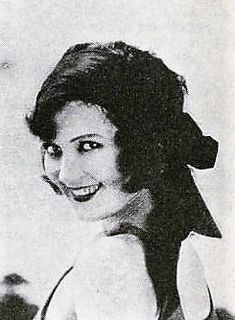Related Research Articles

Lila Lee was a prominent screen actress, primarily a leading lady, of the silent film and early sound film eras.

Mary Brian was an American actress, who made the transition from silent films to sound films.

Arthur Charles Miller, A.S.C. was an American cinematographer. He was nominated for the Oscar for Best Cinematography six times, winning three times: for How Green Was My Valley in 1941, The Song of Bernadette in 1944, and Anna and the King of Siam in 1947.

Helen Jerome Eddy was a motion picture actress from New York City. She was noted as a character actress who played genteel heroines in films such as Rebecca of Sunnybrook Farm (1917).

Doris Margaret Kenyon was an American actress of motion pictures and television.

Dorothy Revier was an American actress.

Doris Hill, born Roberta M. Hill, was an American film actress of the 1920s and 1930s.
Keene Thompson was a story, scenario and screenwriter who worked in the film industry from 1920 to 1937.

JamesSmith and Rose Smith were film editors known for their work in the early days of Hollywood, specifically for their work at the American Mutoscope and Biograph Company working as editors for D.W. Griffith.
Ethel Doherty was an American screenwriter, author, and educator active primarily in the 1920s and 1930s.
Gertrude M. Purcell was an American screenwriter, playwright, and stage actress known for her work on films like The Invisible Woman and Destry Rides Again.
Frances Hyland was an American screenwriter active between the late 1920s and the late 1940s. She was the first woman hired as a "gagman" at a film studio, and she wrote dozens of comedic scripts over the course of her career.
Doris Malloy (1901–1955) was an American screenwriter active during the 1920s through the 1940s.
Sylvia Thalberg was an American screenwriter. Her brother was film producer Irving Thalberg.
Mildred Johnston was an American film editor active in the 1920s and 1930s.
Jane Loring (1890-1983) was an American film editor and producer active during the 1920s through the 1940s. She was related to screenwriter Hope Loring.
Verna Willis was an American film editor known for her work on films of the late 1920s during Hollywood's silent era. She was employed by Paramount and was highly regarded for her skill as a cutter.
Adelaide Cannon was an American film editor and script assistant active during the 1920s.
Dwinelle Benthall was an American screenwriter known for her work in the 1920s.

Harry Fischbeck (1879–1968) was a German-born cinematographer who emigrated to the United States where he worked in the American film industry. He was employed by a variety of different studios during his career including Universal, United Artists and Warner Brothers, but primarily for Paramount Pictures. One of his first credits was for the historical The Lincoln Cycle films directed by John M. Stahl.
References
- ↑ "18 Oct 1916, 3 - University Daily Kansan at Newspapers.com". Newspapers.com. Retrieved 2019-02-13.
- ↑ "12 Jun 1920, Page 6 - The Wellington Daily News at Newspapers.com". Newspapers.com. Retrieved 2019-02-13.
- ↑ "20 Jul 1924, 31 - The Los Angeles Times at Newspapers.com". Newspapers.com. Retrieved 2019-02-13.
- ↑ "11 Dec 1927, 59 - Hartford Courant at Newspapers.com". Newspapers.com. Retrieved 2019-02-13.
- ↑ Lyon, Francis D. Twists of fate : an Oscar winner's international career, p. 26 (1993)
- ↑ Grip Department, Action (April 1943) (photograph shows back of Drought in meeting with Betty Grable)
- ↑ Lee, Sonia The Quints Talk!!, Motion Picture (November 1936), p. 51, 84 ("Doris Drought, the script clerk, on whose shoulders is the weight of matching action in following scenes, who must catch any discrepancies in the small movements of the adult characters in the production, holds a stop watch on every moment.")